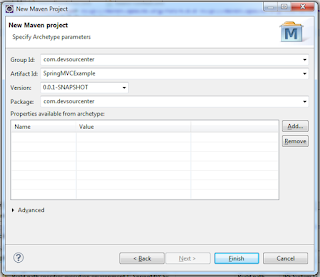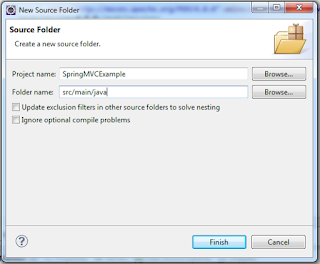First of all create a new project, select Maven project and press next:
Select maven-archetype-webapp:
Configure the project:
Press finish to create the project. If you see error The superclass javax.servlet.http.HttpServlet was not found add Apache Tomcat to the runtime environments.
Create the source folder java:
You should add the dependencies in the pom.xml file, in order to load Spring framework and Jackson libraries:
<project xmlns:xsi="http://www.w3.org/2001/XMLSchema-instance" xmlns="http://maven.apache.org/POM/4.0.0" xsi:schemalocation="http://maven.apache.org/POM/4.0.0 http://maven.apache.org/maven-v4_0_0.xsd">
<modelversion>4.0.0</modelversion>
<groupid>com.devsourcenter</groupid>
<artifactid>SpringMVCExample</artifactid>
<packaging>war</packaging>
<version>0.0.1-SNAPSHOT</version>
<name>SpringMVCExample Maven Webapp</name>
<url>http://maven.apache.org</url>
<dependencies>
<dependency>
<groupid>org.springframework</groupid>
<artifactid>spring-webmvc</artifactid>
<version>4.1.4.RELEASE</version>
</dependency>
<dependency>
<groupid>com.fasterxml.jackson.core</groupid>
<artifactid>jackson-core</artifactid>
<version>2.6.1</version>
</dependency>
<dependency>
<groupid>com.fasterxml.jackson.core</groupid>
<artifactid>jackson-databind</artifactid>
<version>2.6.1</version>
</dependency>
</dependencies>
<build>
<finalname>SpringMVCExample</finalname>
</build>
</project>
Create the mvc-dispatcher.xml file in the application classpath, in order to load the xml containing the beans definition. The tag
<mvc:annotation-driven /> allows us to use the Java annotations in our controller.<beans xmlns="http://www.springframework.org/schema/beans"
xmlns:context="http://www.springframework.org/schema/context"
xmlns:mvc="http://www.springframework.org/schema/mvc" xmlns:xsi="http://www.w3.org/2001/XMLSchema-instance"
xmlns:util="http://www.springframework.org/schema/util"
xsi:schemaLocation="http://www.springframework.org/schema/beans
http://www.springframework.org/schema/beans/spring-beans-4.0.xsd
http://www.springframework.org/schema/mvc
http://www.springframework.org/schema/mvc/spring-mvc-4.0.xsd
http://www.springframework.org/schema/util
http://www.springframework.org/schema/util/spring-util-4.0.xsd
http://www.springframework.org/schema/context
http://www.springframework.org/schema/context/spring-context-4.0.xsd">
<mvc:annotation-driven />
<import resource="classpath:beans-context.xml" />
</beans>
Create the beans-context.xml file in the application classpath, to register our Controller.
<beans xmlns="http://www.springframework.org/schema/beans"
xmlns:context="http://www.springframework.org/schema/context"
xmlns:cache="http://www.springframework.org/schema/cache" xmlns:util="http://www.springframework.org/schema/util"
xmlns:infinispan="http://www.infinispan.org/schemas/spring" xmlns:p="http://www.springframework.org/schema/p"
xmlns:xsi="http://www.w3.org/2001/XMLSchema-instance"
xsi:schemaLocation="http://www.springframework.org/schema/beans
http://www.springframework.org/schema/beans/spring-beans-4.0.xsd
http://www.springframework.org/schema/mvc
http://www.springframework.org/schema/mvc/spring-mvc-4.0.xsd
http://www.springframework.org/schema/util
http://www.springframework.org/schema/util/spring-util-4.0.xsd
http://www.springframework.org/schema/context
http://www.springframework.org/schema/context/spring-context-4.0.xsd">
<bean id="rectangleController" class="com.devsourcenter.controller.RectangleController" />
</beans>
Configure the DispatcherServlet and integrate Spring in web.xml
<web-app xmlns="http://java.sun.com/xml/ns/javaee" xmlns:xsi="http://www.w3.org/2001/XMLSchema-instance"
xsi:schemaLocation="http://java.sun.com/xml/ns/javaee
http://java.sun.com/xml/ns/javaee/web-app_2_5.xsd"
version="2.5">
<display-name>SpringMVCExample</display-name>
<servlet>
<servlet-name>mvc-dispatcher</servlet-name>
<servlet-class>org.springframework.web.servlet.DispatcherServlet</servlet-class>
<init-param>
<param-name>contextConfigLocation</param-name>
<param-value>classpath:/mvc-dispatcher.xml</param-value>
</init-param>
<load-on-startup>1</load-on-startup>
</servlet>
<servlet-mapping>
<servlet-name>mvc-dispatcher</servlet-name>
<url-pattern>/</url-pattern>
</servlet-mapping>
</web-app>
Now Spring is configured, so we can start coding. The Rectangle class will wrap the input data, while the Result class will contain output information:
package com.devsourcenter.model;
public class Rectangle {
private Double length;
private Double width;
public Double getLength() {
return length;
}
public void setLength(Double length) {
this.length = length;
}
public Double getWidth() {
return width;
}
public void setWidth(Double width) {
this.width = width;
}
}
package com.devsourcenter.model;
public class Result {
private Double area;
private Double perimeter;
public Double getArea() {
return area;
}
public void setArea(Double area) {
this.area = area;
}
public Double getPerimeter() {
return perimeter;
}
public void setPerimeter(Double perimeter) {
this.perimeter = perimeter;
}
}
The RectangleController will receive input data and will return the result with area and perimeter. When input data is invalid the controller returns error 400.
package com.devsourcenter.controller;
import org.springframework.http.HttpStatus;
import org.springframework.http.ResponseEntity;
import org.springframework.web.bind.annotation.RequestBody;
import org.springframework.web.bind.annotation.RequestMapping;
import org.springframework.web.bind.annotation.RequestMethod;
import org.springframework.web.bind.annotation.ResponseBody;
import org.springframework.web.bind.annotation.RestController;
import com.devsourcenter.model.Rectangle;
import com.devsourcenter.model.Result;
@RestController
public class RectangleController {
@RequestMapping(value = "/calculate", method = RequestMethod.POST)
public @ResponseBody ResponseEntity<?> calculate(
@RequestBody Rectangle rectangle) {
// check if input data is invalid
if (rectangle.getLength() == null
|| rectangle.getLength() <= 0
|| rectangle.getWidth() == null
|| rectangle.getWidth() <= 0) {
return new ResponseEntity<HttpStatus>(HttpStatus.BAD_REQUEST);
} else {
// if data is valid calculate area and perimeter
Result res = new Result();
res.setArea(rectangle.getLength() * rectangle.getWidth());
res.setPerimeter(2 * (rectangle.getLength()
+ rectangle.getWidth()));
// finally we return the result with status code 200
return new ResponseEntity<Result>(res, HttpStatus.OK);
}
}
}
At this point our Application is complete, this is the final project directory structure:
We can launch the Application by right-clicking on the project SpringMVCExample and selecting Run As
-> Run on Server. After that can perform a test making a PUT call to http://localhost:8080/SpringMVCExample/calculate and passing a valid JSON:






